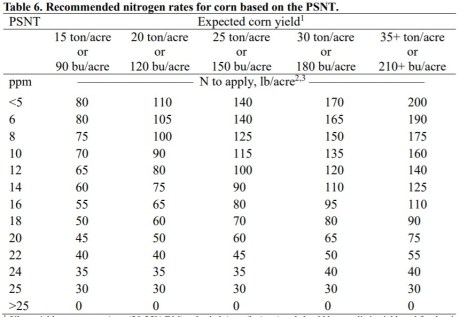It’s time to topdress your corn – remember don’t guess, soil test!
Although nitrogen (N) is one of the most important macronutrients for crop growth, it is not a nutrient you’ll find on your standard soil test report. This is because, unlike the other macro- and micronutrients, N availability is largely driven by microbial activity in the soil and therefore can change rapidly depending on the weather, soil type, moisture, temperature, etc. Soil microorganisms break down organic materials, such as manure, organic matter, and crop residue, and release plant useable forms of N into the soil. Just like livestock, soil microbes are limited by resources such as air, water, and food and are sensitive to fluctuations in temperature. Therefore, crop N needs can be estimated by yield but cannot accurately account for what will actually be made available to the crop. The Pre-Sidedress Nitrate Test, or PSNT, was developed to help farmers more accurately predict crop N needs. The test measures the amount of nitrate-N in the soil at the time the sample was taken. The available nitrate is compared to a model of corn growth and response to N which will tell you how much more N the crop will need to produce the desired yield (Table 1). Applying this level of N decreases the potential for pollution and avoids spending money on unnecessary fertilizer.
Table 1. Sidedress N recommendations based on PSNT results and yield goal. Source: Nutrient Recommendations for Field Crops in Vermont

A PSNT sample should be taken prior to the corn being topdressed, generally this occurs when the corn is 8-12” tall (the V5 to V6 growth stage). Collect 15-20 soil cores per field at a depth of 12”. Just like when you are collecting a normal soil sample, be sure to cover as much of the field as possible to gain a representative sample. Sampling in a W or X pattern can be helpful to ensure good coverage. Also make sure you test a good representative group of your fields accounting for differences in soil type, drainage, and microclimate, which can all impact N availability. When sampling, avoid sampling too close to the corn plants if starter fertilizer was banded at planting.
Once you have collected the samples, keep them cool, and deliver them to a lab that day for analysis. Keeping the soil cool is critical because the soil nitrate-N levels will change quickly. Once the lab receives your sample, they typically return results within 24 hours. Results will include a recommendation for how much additional N is needed to obtain your yield goal. Instructions for submitting a sample to the UVM Agricultural and Environmental Testing Laboratory can be found here (http://www.uvm.edu/pss/ag_testing/PSNT_multi_form.pdf).
Interested in learning more about the PSNT and other nutrient recommendations? Check out this handy guide: Nutrient Recommendations for Field Crops in Vermont (https://www.uvm.edu/sites/default/files/Agriculture/NutrientRecs_BR1390.2.pdf).